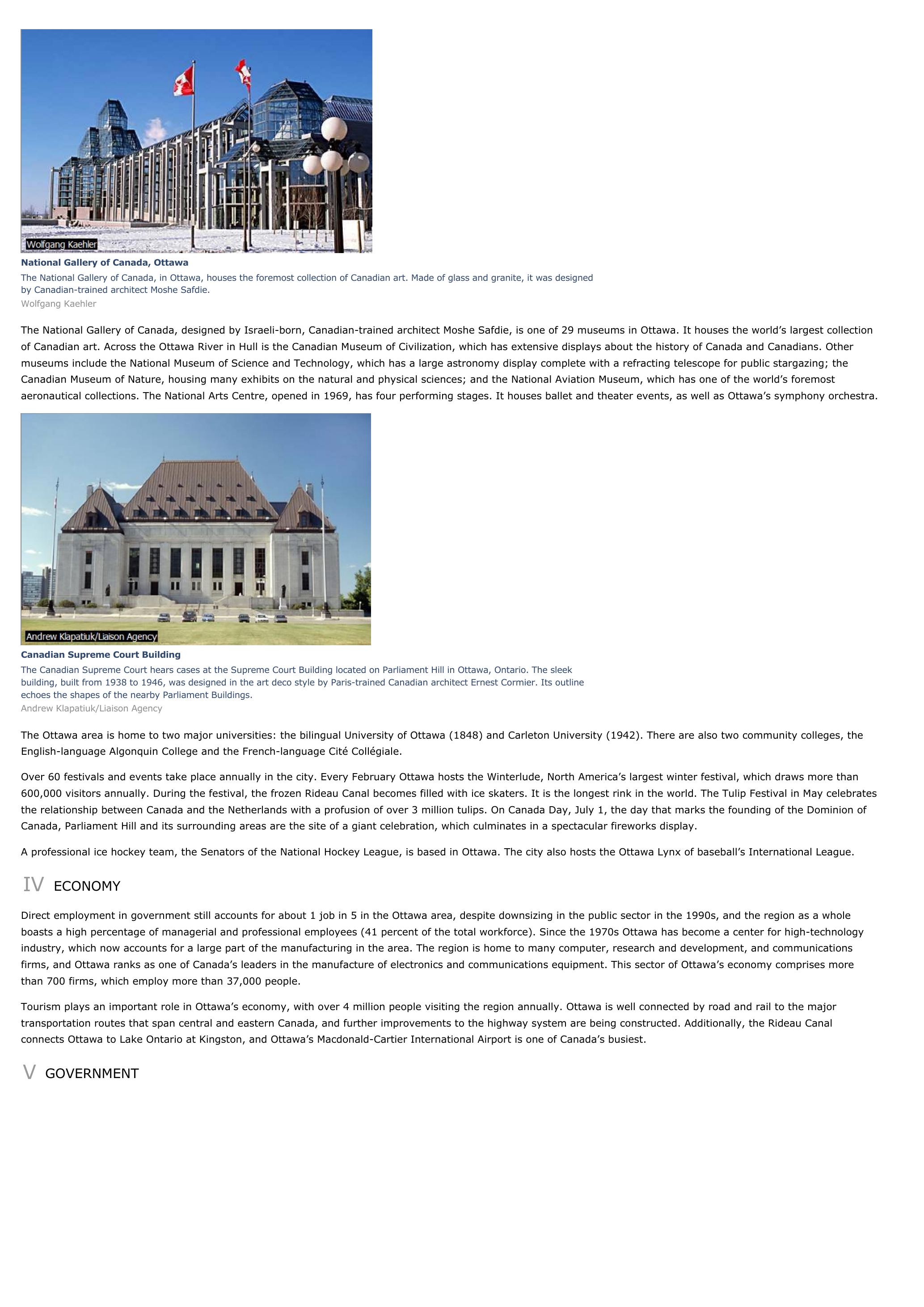Ottawa (city, Ontario) - geography.
Publié le 26/05/2013

Extrait du document
«
National Gallery of Canada, OttawaThe National Gallery of Canada, in Ottawa, houses the foremost collection of Canadian art.
Made of glass and granite, it was designedby Canadian-trained architect Moshe Safdie.Wolfgang Kaehler
The National Gallery of Canada, designed by Israeli-born, Canadian-trained architect Moshe Safdie, is one of 29 museums in Ottawa.
It houses the world’s largest collectionof Canadian art.
Across the Ottawa River in Hull is the Canadian Museum of Civilization, which has extensive displays about the history of Canada and Canadians.
Othermuseums include the National Museum of Science and Technology, which has a large astronomy display complete with a refracting telescope for public stargazing; theCanadian Museum of Nature, housing many exhibits on the natural and physical sciences; and the National Aviation Museum, which has one of the world’s foremostaeronautical collections.
The National Arts Centre, opened in 1969, has four performing stages.
It houses ballet and theater events, as well as Ottawa’s symphony orchestra.
Canadian Supreme Court BuildingThe Canadian Supreme Court hears cases at the Supreme Court Building located on Parliament Hill in Ottawa, Ontario.
The sleekbuilding, built from 1938 to 1946, was designed in the art deco style by Paris-trained Canadian architect Ernest Cormier.
Its outlineechoes the shapes of the nearby Parliament Buildings.Andrew Klapatiuk/Liaison Agency
The Ottawa area is home to two major universities: the bilingual University of Ottawa (1848) and Carleton University (1942).
There are also two community colleges, theEnglish-language Algonquin College and the French-language Cité Collégiale.
Over 60 festivals and events take place annually in the city.
Every February Ottawa hosts the Winterlude, North America’s largest winter festival, which draws more than600,000 visitors annually.
During the festival, the frozen Rideau Canal becomes filled with ice skaters.
It is the longest rink in the world.
The Tulip Festival in May celebratesthe relationship between Canada and the Netherlands with a profusion of over 3 million tulips.
On Canada Day, July 1, the day that marks the founding of the Dominion ofCanada, Parliament Hill and its surrounding areas are the site of a giant celebration, which culminates in a spectacular fireworks display.
A professional ice hockey team, the Senators of the National Hockey League, is based in Ottawa.
The city also hosts the Ottawa Lynx of baseball’s International League.
IV ECONOMY
Direct employment in government still accounts for about 1 job in 5 in the Ottawa area, despite downsizing in the public sector in the 1990s, and the region as a wholeboasts a high percentage of managerial and professional employees (41 percent of the total workforce).
Since the 1970s Ottawa has become a center for high-technologyindustry, which now accounts for a large part of the manufacturing in the area.
The region is home to many computer, research and development, and communicationsfirms, and Ottawa ranks as one of Canada’s leaders in the manufacture of electronics and communications equipment.
This sector of Ottawa’s economy comprises morethan 700 firms, which employ more than 37,000 people.
Tourism plays an important role in Ottawa’s economy, with over 4 million people visiting the region annually.
Ottawa is well connected by road and rail to the majortransportation routes that span central and eastern Canada, and further improvements to the highway system are being constructed.
Additionally, the Rideau Canalconnects Ottawa to Lake Ontario at Kingston, and Ottawa’s Macdonald-Cartier International Airport is one of Canada’s busiest.
V GOVERNMENT.
»
↓↓↓ APERÇU DU DOCUMENT ↓↓↓
Liens utiles
- Ottawa (city, Ontario) - Geography.
- Buenos Aires (city) - geography.
- Dublin (city, Ireland) - geography.
- Mexico City - geography.
- Moscow (city, Russia) - geography.

































